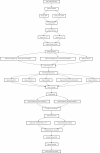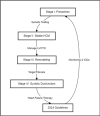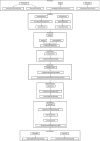Obstructive hypertrophic cardiomyopathy: from genetic insights to a multimodal therapeutic approach with mavacamten, aficamten, and beyond
- PMID: 39645546
- PMCID: PMC11625047
- DOI: 10.1186/s43044-024-00587-y
Obstructive hypertrophic cardiomyopathy: from genetic insights to a multimodal therapeutic approach with mavacamten, aficamten, and beyond
Abstract
Background: A cardiac condition marked by excessive growth of heart muscle cells, hypertrophic cardiomyopathy (HCM) is a complex genetic disorder characterized by left ventricular hypertrophy, microvascular ischemia, myocardial fibrosis, and diastolic dysfunction. Obstructive hypertrophic cardiomyopathy (oHCM), a subset of HCM, involves significant obstruction in the left ventricular outflow tract (LVOT), leading to symptoms like dyspnea, fatigue, and potentially life-threatening cardiac events. With advancements in genetic understanding and the introduction of novel pharmacologic agents, including cardiac myosin inhibitors like mavacamten and aficamten, there is a paradigm shift in the therapeutic approach to oHCM.
Main body: The underlying mechanisms of HCM are closely tied to genetic mutations affecting sarcomere proteins, particularly those encoded by the MYH7 and MYBPC3 genes. These mutations lead to disrupted sarcomere function, resulting in hypertrophic changes and LVOT obstruction. While genetic heterogeneity is a hallmark of HCM, clinical diagnosis relies heavily on imaging techniques such as Echocardiography and cardiac magnetic resonance imaging to assess the extent of hypertrophy and obstruction. Current pharmacological management of obstructive HCM (oHCM) focuses on alleviating symptoms rather than modifying disease progression. Beta-blockers and calcium channel blockers are primary treatment options, although their effectiveness varies among patients. Recent clinical trials have highlighted the potential of novel cardiac myosin inhibitors, including mavacamten and aficamten, in enhancing exercise capacity, reducing LVOT obstruction, and improving overall cardiac function. These innovative agents represent a significant breakthrough in targeting the fundamental pathophysiological mechanisms driving oHCM. A comprehensive literature review was conducted, utilizing top-tier databases such as PubMed, Scopus, and Google Scholar, to compile an authoritative and up-to-date overview of the current advancements in the field. This review sheds light on the updated 2024 American Heart Association (AHA) guidelines for HCM management, emphasizing the treatment cascade and tailored management for each stage of oHCM. By introducing a new paradigm for personalized medicine in oHCM, this research leverages advanced genomics, biomarkers, and imaging techniques to optimize treatment strategies.
Conclusions: The introduction of cardiac myosin inhibitors heralds a new era in the management of oHCM. By directly targeting the molecular mechanisms underpinning the disease, these novel therapies offer improved symptom relief and functional outcomes. Ongoing research into the genetic basis of HCM and the development of targeted treatments holds promise for further enhancing patient care. Future studies should continue to refine these therapeutic strategies and explore their long-term benefits and potential in diverse patient populations. This review makes a significant contribution to the field by synthesizing the most recent AHA guidelines, emphasizing the crucial role of tailored management strategies in optimizing outcomes for patients with oHCM, and promoting the incorporation of cutting-edge genomics and imaging modalities to enhance personalized care.
Keywords: Aficamten; Cardiac magnetic resonance imaging; Genetic mutations; HCM; Mavacamten; Myosin inhibitors; Septal reduction therapy; oHCM.
© 2024. The Author(s).
Conflict of interest statement
Declarations. Ethics approval and consent to participate: Not applicable. Consent for publication: Not applicable. Competing interests: The authors declare no potential conflicts of interest concerning the research, authorship, and/or publication of this article.
Figures







Similar articles
-
Depressing time: Waiting, melancholia, and the psychoanalytic practice of care.In: Kirtsoglou E, Simpson B, editors. The Time of Anthropology: Studies of Contemporary Chronopolitics. Abingdon: Routledge; 2020. Chapter 5. In: Kirtsoglou E, Simpson B, editors. The Time of Anthropology: Studies of Contemporary Chronopolitics. Abingdon: Routledge; 2020. Chapter 5. PMID: 36137063 Free Books & Documents. Review.
-
Qualitative evidence synthesis informing our understanding of people's perceptions and experiences of targeted digital communication.Cochrane Database Syst Rev. 2019 Oct 23;10(10):ED000141. doi: 10.1002/14651858.ED000141. Cochrane Database Syst Rev. 2019. PMID: 31643081 Free PMC article.
-
Falls prevention interventions for community-dwelling older adults: systematic review and meta-analysis of benefits, harms, and patient values and preferences.Syst Rev. 2024 Nov 26;13(1):289. doi: 10.1186/s13643-024-02681-3. Syst Rev. 2024. PMID: 39593159 Free PMC article.
-
Outcomes of a multidisciplinary approach to management of mavacamten in obstructive hypertrophic cardiomyopathy.Am J Health Syst Pharm. 2024 Nov 29:zxae372. doi: 10.1093/ajhp/zxae372. Online ahead of print. Am J Health Syst Pharm. 2024. PMID: 39611751
-
Effectiveness of interpersonal psychotherapy in comparison to other psychological and pharmacological interventions for reducing depressive symptoms in women diagnosed with postpartum depression in low- and middle-income countries: A systematic review.Campbell Syst Rev. 2024 Apr 21;20(2):e1399. doi: 10.1002/cl2.1399. eCollection 2024 Jun. Campbell Syst Rev. 2024. PMID: 38645302 Free PMC article. Review.
References
-
- Ommen SR, Mital S, Burke MA, Day SM, Deswal A, Elliott P et al (2020) 2020 AHA/ACC guideline for the diagnosis and treatment of patients with hypertrophic cardiomyopathy: a report of the American College of Cardiology/American Heart Association Joint Committee on Clinical Practice Guidelines. J Am Coll Cardiol 76(25):e159–e240 - PubMed
-
- Maron BJ, Gardin JM, Flack JM, Gidding SS, Kurosaki TT, Bild DE (1995) Prevalence of hypertrophic cardiomyopathy in a general population of young adults: echocardiographic analysis of 4111 subjects in the CARDIA study. Circulation 92(4):785–789 - PubMed
-
- Maron BJ, Ommen SR, Semsarian C, Spirito P, Olivotto I, Maron MS (2014) Hypertrophic cardiomyopathy: present and future, with translation into contemporary cardiovascular medicine. J Am Coll Cardiol 64(1):83–99 - PubMed
Publication types
LinkOut - more resources
Full Text Sources
